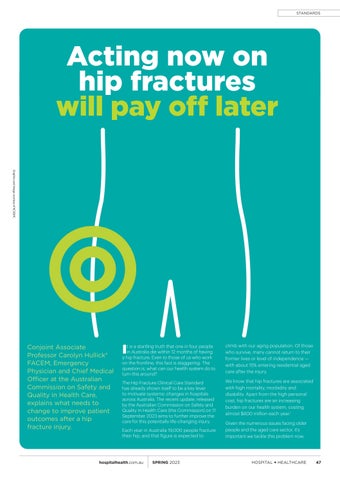STANDARDS
Acting now on hip fractures will pay off later Graphics and image courtesy of ACSQHC.
Conjoint Associate Professor Carolyn Hullick* FACEM, Emergency Physician and Chief Medical Officer at the Australian Commission on Safety and Quality in Health Care, explains what needs to change to improve patient outcomes after a hip fracture injury.
I
t is a startling truth that one in four people in Australia die within 12 months of having a hip fracture. Even to those of us who work on the frontline, this fact is staggering. The question is, what can our health system do to turn this around?
climb with our aging population. Of those who survive, many cannot return to their former lives or level of independence — with about 15% entering residential aged care after the injury.
The Hip Fracture Clinical Care Standard has already shown itself to be a key lever to motivate systemic changes in hospitals across Australia. The recent update, released by the Australian Commission on Safety and Quality in Health Care (the Commission) on 11 September 2023 aims to further improve the care for this potentially life-changing injury.
We know that hip fractures are associated with high mortality, morbidity and disability. Apart from the high personal cost, hip fractures are an increasing burden on our health system, costing almost $600 million each year.i
Each year in Australia 19,000 people fracture their hip, and that figure is expected to
hospitalhealth.com.au
SPRING 2023
Given the numerous issues facing older people and the aged care sector, it’s important we tackle this problem now.
HOSPITAL + HEALTHCARE
47
